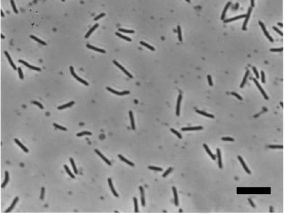Tenacibaculum amylolyticum
Classification
Domain: Bacteria
Phylum: Bacteroidetes
Class: Flavobacteriia
Order: Flavobacteriales
Family: Flavobacteriaceae
Species
Tenacibaculum amylolyticum Type strain: MBIC 4355T (= IFO 16310T)
The genus name "Tenacibaculum" comes from the Latin words tenax meaning "holding fast" and baculum meaning "a stick." The name "amylolyticum" was created using the Greek words amylum and lyticos, which translate to "starch" and "loosening/dissolving," respectively.[1]
Description and Significance
Tenacibaculum amylolyticum was originally discovered by members of the Marine Biotechnology Institute and the Institute for Fermentation in 2001. It and other bacterial strains were found living on samples of sponge and green algae that had been gathered from waters by the Pacific island of Palau and off the coast of Japan. Tenacibaculum amylolyticum was especially prominent on the surface of macroalgae, specifically Avrainvillea riukiuensisi collected from Palau.[1]
Tenacibaculum amylolyticum is a rod-shaped, Gram-negative, flexirubin-negative bacterium. It shows gliding motility, does not form gas vesicles or spores, and is mesophilic. They are typically 2-5µm in length and 0.4µm in diameter. Tenacibaculum amylolyticum is cultured with a liquid medium and requires oxygen for growth. At least half-strength sea water must be used as the medium in order for the microbe to grow. These bacteria can survive in a pH between 5.3 and 8.3. Being a mesophile, Tenacibaculum amylolyticum grows best at moderate temperatures. It grows well between 19°C and 35°C with an optimal temperature occurring between 27°C and 33°C. These bacteria cannot live at temperatures below 15°C or above 40°C. When cultured and incubated, a yellow colony forms with irregular edges.[1]
These bacteria contain zeaxanthin as the major carotenoid pigment, giving it its bright yellow colony color, with beta-cyrptoxanthin and beta-carotene as lesser components.[1]
Tenacibaculum amylolyticum is part of the Cytophaga-Flavobacterium-Bacteroides (CFB) complex. This group of bacteria decompose biomacromolecules and are an important player in the marine/aquatic portion of the carbon cycle.[2] They actively participate in the soil aggregate cycle by using enzymes that decompose and mineralize soil organic carbon faster than plants can fix carbon dioxide. This affects the formation of soil aggregates that sequester carbon dioxide and less plant productivity due to the loss of available organic carbon.[3] They also are known to affect the shape development of macroalgae. It is possible that Tenacibaculum amylolyticum has a role in climate change and has an effect on the morphogenesis of the algae it grows on.[1]
Phase-contrast microphotograph of Tenacibaculum amylolyticum grown on 1/5 LBM agar at 20 degrees C for 3 days[1]
Genome Structure
This bacteria is part of the marine MK-6 group of bacteria, meaning that analysis of the amino acid sequences of the gyrB gene, which encodes the subunit B protein of DNA gyrase [4], contains methaquione-6 (MK-6). It has a G+C content of 31 mol% and a 16S rDNA similarity of 95.5% with Tenacibaculum mesophilum. However, "Tenacibaculum amylolyticum" does not have high levels of DNA relatedness with other members of the Tenacibaculum genus and shows low levels of DNA-DNA hybridization with other strains. [1]
The 16s rRNA and gyrB gene sequences are available here: [5]
Metabolism
Tenacibaculum amylolyticum is an obligate aerobe and a heterotroph. This bacteria is catalase and oxidase positive. "Tenacibaculum amylolyticum" has the ability to hydrolyze starch, casein, proteinogenic amino acids (tyrosine), peptide-protein mixes (gelatin), Polysorbate 80, and DNA. The microbe gets its energy through the process of amylolysis, the process of using enzymes to split starch into soluble products [6], hence the species name "amylolyticum." Growth can occur with peptone, typtone, Casamino acids, L-proline, and L-glutamate as the only carbon and nitrogen sources. This bacteria weakly reduces nitrate and is has less osmotic tolerance than closely related species, it is only weakly supported on 3 % (w/v) NaCl medium. [1]
Ecology
Tenacibaculum amylolyticum grows in marine environments. It has been found living on the surface of algae, and is most associated with green algae. Along with its discovery, one more species was found and two more warranted reclassification. The other new species found was Tenacibaculum mesophilum, which is the closest known related species to Tenacibaculum amylolyticum. Flexibacter ovolyticus and Flexibacter maritimus were reclassified as Tenacibaculum ovolyticum and Tenacibaculum maritimus, respectively, due to their genomic evaluation. The interaction between these species is relatively unknown.[1]
References
[5] DMZ "Tenacibaculum amylolyticum". DMZ catalogues. 2014. Web. 20 Apr 2014.
[6] "amylolytic". Merriam-Webster.com. Merriam-Webster, 2014. Web. 20 Apr 2014.
Author
Page authored by Brian McElroy and Samantha Heinrich, students of Prof. Ned Walker at Michigan State University.

